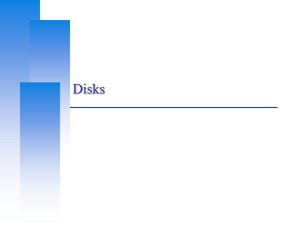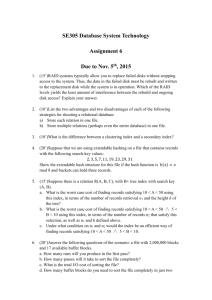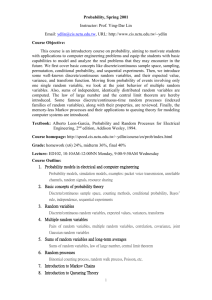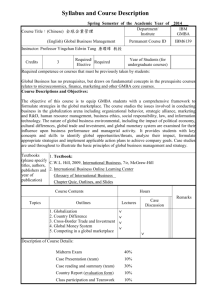ppt
advertisement
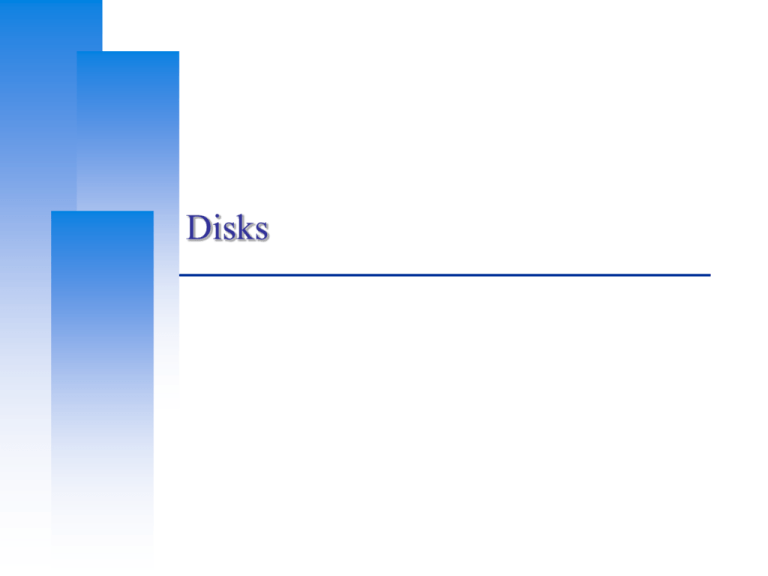
Disks
Computer Center, CS, NCTU
Outline
Interfaces
Geometry
Add new disks
• Installation procedure
• Filesystem check
• Add a disk using sysinstall
RAID
• GEOM
Appendix – SCSI & SAS
2
Computer Center, CS, NCTU
Disk Interfaces
SCSI
• Small Computer Systems Interface
• High performance and reliability
IDE (or ATA)
• Integrated Device Electronics (or AT Attachment)
• Low cost
• Become acceptable for enterprise with the help of RAID technology
SATA
• Serial ATA
SAS
• Serial Attached SCSI
USB
• Universal Serial Bus
• Convenient to use
3
Computer Center, CS, NCTU
Disk Interfaces –
ATA & SATA
ATA (AT Attachment)
• ATA2
PIO, DMA
LBA (Logical Block Addressing)
• ATA3, Ultra DMA/33/66/100/133
• ATAPI (ATA Packet Interface)
CDROM, TAPE
• Only one device can be active at a time
SCSI support overlapping commands, command queuing, scattergather I/O
• Master-Slave
• 40-pin ribbon cable
SATA
• Serial ATA
• SATA-1 1.5Gbit/s, SATA-2 3Gbit/s, SATA-3 6GBit/s
4
Computer Center, CS, NCTU
5
Disk Interfaces –
ATA & SATA Interfaces
ATA interface and it’s cable
SATA interface and it’s cable
Computer Center, CS, NCTU
6
Disk Interfaces –
USB
IDE/SATA to USB
Converter
Computer Center, CS, NCTU
Disk Geometry (1)
sector
• Individual data block
track
• circle
cylinder
•
circle on all platters
Position
• CHS
• Cylinder, Head, Sector
7
Computer Center, CS, NCTU
Disk Geometry (2)
40G HD
• 4866 cylinders, 255 heads
• 63 sectors per track, 512 bytes per sector
• 512 * 63 * 4866 * 255 = 40,024,212,480 bytes
• 1KB = 1024 bytes
• 1MB = 1024 KB = 1,048,576 bytes
• 1GB = 1024 MB = 1,073,741,824 bytes
• 40,024,212,480 / 1,073,741,824 ≒ 37.275 GB
8
Disk Installation Procedure
Computer Center, CS, NCTU
Disk Installation Procedure (1)
The procedure involves the following steps:
• Connecting the disk to the computer
IDE: master/slave
SATA
SCSI: ID, terminator
power
• Creating device files
Auto created by devfs
• Formatting the disk
Low-level format
– Address information and timing marks on platters
– bad sectors
Manufacturer diagnostic utility
10
Computer Center, CS, NCTU
Disk Installation Procedure (2)
• Partitioning and Labeling the disk
Allow the disk to be treated as a group of independent data
area
root, home, swap partitions
Suggestion:
– /var, /tmp separate partition
– Make a copy of root filesystem for emergency
• Establishing logical volumes
Combine multiple partitions into a logical volume
Software RAID technology
– GEOM: geom(4)、geom(8)
– ZFS: zpool(8)、zfs(8)、zdb(8)
11
Computer Center, CS, NCTU
Disk Installation Procedure (3)
• Creating UNIX filesystems within disk partitions
Use “newfs” to install a filesystem for a partition
Filesystem components
– A set of inode storage cells
– A set of data blocks
– A set of superblocks
– A map of the disk blocks in the filesystem
– A block usage summary
12
Computer Center, CS, NCTU
Disk Installation Procedure (4)
Superblock contents
– The length of a disk block
– Inode table’s size and location
– Disk block map
– Usage information
– Other filesystem’s parameters
sync
– The sync() system call forces a write of dirty (modified) buffers in
the block buffer cache out to disk.
– The sync utility can be called to ensure that all disk writes have
been completed before the processor is halted in a way not suitably
done by reboot(8) or halt(8).
13
Computer Center, CS, NCTU
Disk Installation Procedure (5)
• mount
Bring the new partition to the filesystem tree
mount point can be any directory
# mount /dev/ad1s1e /home2
• Setting up automatic mounting
Automount at boot time
– /etc/fstab
– % mount –t ufs /dev/ad2s1a /backup
– % mount –t cd9600 –o ro,noauto /dev/acd0c /cdrom
liuyh@NASA:/etc> cat fstab
# Device
Mountpoint
/dev/ad0s1b
none
/dev/ad2s1b
none
/dev/ad0s1a
/
/dev/acd0
/cdrom
/dev/ad2s1a
/backup
csduty:/bsdhome /bsdhome
14
Fstype
swap
swap
ufs
cd9660
ufs
nfs
Options
sw
sw
rw
ro,noauto
rw,noauto
rw,noauto
Dump
0
0
1
0
2
0
Pass#
0
0
1
0
2
0
Computer Center, CS, NCTU
15
Disk Installation Procedure (6)
• Setting up swapping on swap partitions
swapon, swapoff, swapctl
swapinfo, pstat
Computer Center, CS, NCTU
fsck –
check and repair filesystem (1)
System crash will cause
• Inconsistency between memory image and disk contents
fsck
• Examine all local filesystem listed in /etc/fstab at boot time. (fsck -p)
• Automatically correct the following damages:
Unreferenced inodes
Inexplicably large link counts
Unused data blocks not recorded in block maps
Data blocks listed as free but used in file
Incorrect summary information in the superblock
fsck(8)、fsck_ffs(8)
ffsinfo(8): dump metadata
16
Computer Center, CS, NCTU
fsck –
check and repair filesystem (2)
Run fsck in manual to fix serious damages
• Blocks claimed by more than one file
•
•
•
•
Blocks claimed outside the range of the filesystem
Link counts that are too small
Blocks that are not accounted for
Directories that refer to unallocated inodes
• Other errors
fsck will suggest you the action to perform
• Delete, repair, …
17
Computer Center, CS, NCTU
Adding a disk to FreeBSD (1)
1.
Check disk connection
>
ad3: 238475MB <Hitachi HDS722525VLAT80 V36OA6MA> at ata1-slave UDMA100
2.
Use /usr/sbin/sysinstall to install the new HD
>
Configure Fdisk Label
>
>
>
3.
4.
Don’t forget to “W” the actions
Easiest approach, but has some problems.
fdisk(8), bsdlabel(8), newfs(8)
Make mount point and mount it
>
>
>
18
Look system boot message
# mkdir /home2
# mount –t ufs /dev/ad3s1e /home2
# df
Edit /etc/fstab
Computer Center, CS, NCTU
Adding a disk to FreeBSD (2)
If you forget to enable soft-update when you add the disk
•
•
•
•
% umount /home2
% tunefs –n enable /dev/ad3s1e
% mount –t ufs /dev/ad3s1e /home2
% mount
/dev/ad0s1a on / (ufs, local, soft-updates)
/dev/ad1s1e on /home (ufs, local, soft-updates)
procfs on /proc (procfs, local)
/dev/ad3s1e on /home2 (ufs, local, soft-updates)
19
RAID
Computer Center, CS, NCTU
RAID – (1)
Redundant Array of Inexpensive Disks
• A method to combine several physical hard drives into one logical
unit
Depending on the type of RAID, it has the following
benefits:
• Fault tolerance
• Higher throughput
• Real-time data recovery
RAID Level
• RAID 0, 1, 0+1, 2, 3, 4, 5, 6
• Hierarchical RAID
21
Computer Center, CS, NCTU
RAID – (2)
Hardware RAID
• There is a dedicate controller to take over the whole business
• RAID Configuration Utility after BIOS
Create RAID array, build Array
Software RAID
GEOM
– CACHE、CONCAT、ELI、JOURNAL、LABEL、MIRROR、
MULTIPATH、NOP、PART、RAID3、SHSEC、STRIPE、
VIRSTOR
ZFS
– JBOD、STRIPE
– MIRROR
– RAID-Z、RAID-Z2、RAID-Z3
22
Computer Center, CS, NCTU
RAID 0
Stripped data intro several disks
Minimum number of drives: 2
Advantage
• Performance increase in proportional to n theoretically
• Simple to implement
Disadvantage
• No fault tolerance
Recommended applications
• Non-critical data storage
• Application requiring high bandwidth (such as video editing)
23
Computer Center, CS, NCTU
RAID 1
Mirror data into several disks
Minimum number of drives: 2
Advantage
• 100% redundancy of data
Disadvantage
• 100% storage overage
• Moderately slower write performance
Recommended application
• Application requiring very high availability (such as home)
24
Computer Center, CS, NCTU
25
RAID 0+1
Combine RAID 0 and RAID 1
Minimum number of drives: 4
Computer Center, CS, NCTU
RAID 2
Hamming Code ECC Each bit of data word
Advantages:
• "On the fly" data error correction
Disadvantages:
• Inefficient
• Very high ratio of ECC disks to data disks
Recommended Application
• No commercial implementations exist / not commercially viable
26
Computer Center, CS, NCTU
RAID 3
Parallel transfer with Parity
Minimum number of drives: 3
Advantages:
• Very high data transfer rate
Disadvantages:
• Transaction rate equal to that of a single disk drive at best
Recommended Application
• Any application requiring high throughput
27
Computer Center, CS, NCTU
28
RAID 4
Similar to RAID3
RAID 3 V.S RAID 4
• Byte Level V.S Block Level
• Block interleaving
Computer Center, CS, NCTU
29
RAID 5
Independent Disk with distributed parity blocks
Minimum number of drives: 3
Advantage
• Highest read data rate
• Medium write data rate
Disadvantage
•
•
•
•
Disk failure has a medium impact on throughput
Complex controller design
When one disk failed, you have to rebuild the RAID array
“write hole”
Computer Center, CS, NCTU
30
RAID 6
Similar to RAID5
Minimum number of drives: 4
2 parity checks, 2 disk failures tolerable.
GEOM
Modular Disk Transformation Framework
Computer Center, CS, NCTU
GEOM – (1)
Support
•
•
•
•
•
•
ELI – geli(8): cryptographic GEOM class
JOURNAL – gjournal(8): journaled devices
LABEL – glabel(8): disk labelization
MIRROR – gmirror(8): mirrored devices
STRIPE – gstripe(8): striped devices
…
• http://www.freebsd.org/doc/handbook/geom.html
32
Computer Center, CS, NCTU
GEOM – (2)
GEOM framework in FreeBSD
• Major RAID control utilities
• Kernel modules (/boot/kernel/geom_*)
• Name and Prodivers
“manual” or “automatic”
Metadata in the last sector of the providers
Kernel support
• {glabel,gmirror,gstripe,g*} load/unload
device GEOM_* in kernel config
geom_*_enable=“YES” in /boot/loader.conf
33
Computer Center, CS, NCTU
GEOM – (3)
LABEL
• Used for GEOM provider labelization.
• Kernel
device GEOM_LABEL
geom_label_load=“YES”
• glabel
# glabel label -v usr da2
# newfs /dev/label/usr
# mount /dev/label/usr /usr
# glabel stop usr
# glabel clear da2
• UFS label
# tunefs -L data /dev/da4s1a
# mount /dev/ufs/data /mnt/data
34
Computer Center, CS, NCTU
GEOM – (4)
MIRROR
• Used for GEOM provider labelization.
• Kernel
device GEOM_MIRROR
geom_mirror_load=“YES”
• gmirror
# gmirror label -v -b round-robin data da0
# newfs /dev/mirror/data
# mount /dev/mirror/data /mnt
# gmirror insert data da1
# gmirror forget data
# gmirror insert data da1
# gmirror stop data
# gmirror clear da0
35
Computer Center, CS, NCTU
GEOM – (5)
STRIPE
• Used for GEOM provider labelization.
• Kernel
device GEOM_STRIPE
geom_stripe_load=“YES”
• gstripe
# gstripe label -v -s 131072 data da0 da1 da2 da3
# newfs /dev/stripe/data
# mount /dev/stripe/data /mnt
# gstripe stop data
# gstripe clear da0
36
Appendix
SCSI & SAS
Computer Center, CS, NCTU
38
Disk Interfaces –
SCSI Interface Evolution
Version
Freq.
Width
Speed
Length
Diff.
SCSI-1
5MHz
8 bits
5MB/s
6m
25m
SCSI-2
5MHz
8 bits
5MB/s
6m
25m
SCSI-2 Fast
10MHz
8 bits
10MB/s
3m
25m
SCSI-2 Fast Wide
10MHz
16 bits
20MB/s
3m
25m
Ultra SCSI
20MHz
8 bits
20MB/s
1.5m
25m
Ultra Wide SCSI
20MHz
16 bits
40MB/s
1.5m
25m
Ultra2 SCSI
40MHz
16 bits
80MB/s
-
12m
Ultra160 SCSI
80MHz
16 bits
160MB/s
-
12m
Ultra320 SCSI
160MHz
16 bits
320MB/s
-
12m
Computer Center, CS, NCTU
39
Disk Interfaces –
SCSI Interface Connector
Computer Center, CS, NCTU
40
Disk Interfaces –
SCSI Interface
Daisy chain on SCSI bus
• Most external devices have two SCSI ports
• Terminator
Each SCSI device has a SCSI ID
Computer Center, CS, NCTU
41
Disk Interfaces –
SAS
SAS – Serial Attached SCSI
SAS vs parallel SCSI
• SAS uses Serial transfer protocol to interface multiple devices hence lesser
signaling overhead than parallel SCSI, resulting in higher speed.
• No bus contention as SAS bus is point-to-point while SCSI bus is multidrop.
Each device is connected by a dedicated bus to the initiator. Connection
through expanders may appear to cause some contention, but this is
transparent to the initiator.
• SAS has no termination issues and does not require terminator packs like
parallel SCSI.
• SAS eliminates skew.
• SAS supports higher number of devices (> 16384) while Parallel SCSI
limits it to 16 or 32.
• SAS supports higher transfer speed (1.5, 3.0 or 6.0 Gbps). The speed is
realized on each initiator-target connection, hence higher throughput
whereas in parallel SCSI the speed is shared across the entire multidrop bus.
• SAS supports SATA devices.
• SAS uses SCSI commands to interface with SAS End devices.


